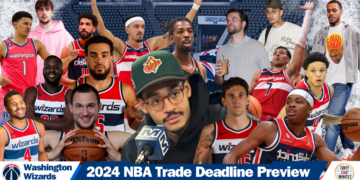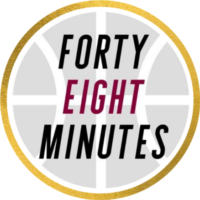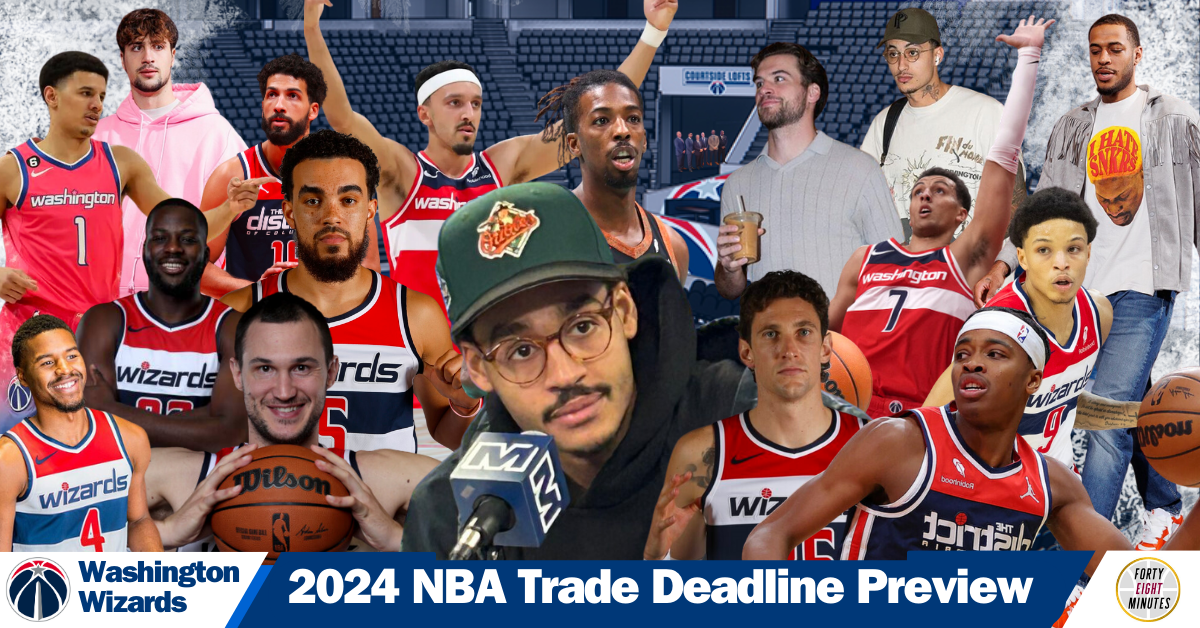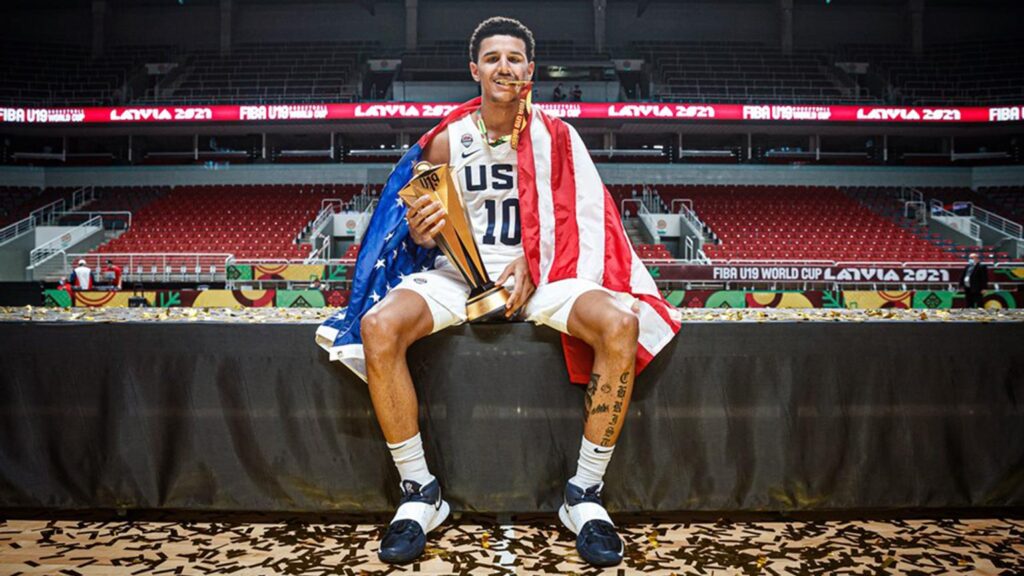Happy trade season! The 2024 NBA Trade Deadline is February 8 and the Washington Wizards are one of the teams that are sure to be active ahead of it.
Below is a breakdown of Washington’s roster in terms of trade value and educated predictions ahead of the trade deadline based on the NBA landscape.
Similar to the 2020 Trade Deadline Primer series produced for SLAM, we’ll break down the Wizards’ roster into categories:
- Wizards Unlikely To Be Traded
- Wizards Expected To Be Traded
- Biggest Name Who Could Be Traded
- Wait-and-See Wizards
- Wizards’ Tradable Two-Way Contracts
- Trades Are Possible
Hope you enjoy the analysis!

Players Unlikely To Be Traded
- F Deni Avdija
- F Patrick Baldwin Jr.
- G/F Bilal Coulibaly
- G Johnny Davis
Deni Avdija currently holds the distinction as the longest-tenured Wizards and the 2019 first-round pick (No. 9 overall) is unlikely to be traded for multiple reasons.
Avdija’s recently signed extension makes it difficult for the team to match salary in a potential trade as a result of the poison pill provision that comes with rookie scale extensions.
In Avdija’s case, there’s a nearly $6 million delta between what his outgoing salary needs to be ($6.26 million) and incoming salary trade requirements ($12.25 million).
We detailed how Avdija’s offseason work is fueling his progress in a feature earlier this year and it would be an upset if he’s not in Washington next summer to build upon that progress.
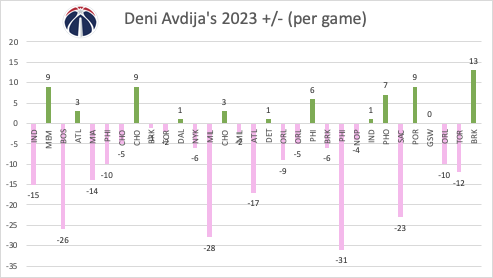
The story of Patrick Baldwin Jr. is an interesting one to track.
Baldwin was a top high school recruit before his uninspiring freshman campaign at UW-Milwaukee resulted in him falling to the No. 28 overall pick in the 2022 draft (Warriors).
There’s an argument to be made that the 21-year-old forward could become the best asset01 that the Wizards received in the Bradley Beal trade (and Chris Paul subsequential flip).
It would be surprising to see the team give up on Baldwin before the deadline.
The Wizards’ two most recent first-round picks qualify for the unlikely-to-be-traded tier for slightly different reasons.
Giving up on 2023 No. 7 overall pick Bilal Coulibaly—the team’s most valuable prospect—so soon would signal a disaster and massive shift in Washington’s strategy given the communicated long-term plan.
The 19-year-old would likely fetch a hefty return if a trade were to occur, however.
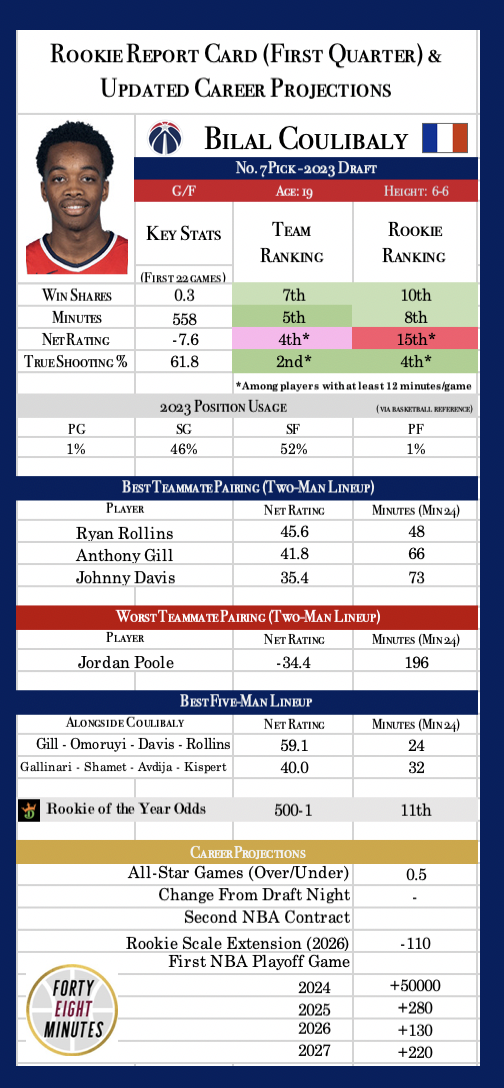
Similarly, there’s no impetus for a Johnny Davis trade. Yet, unlike with Coulibaly, it’s hard to see the long-term upside.
Davis has struggled to earn minutes for the Wizards since being selected with the No. 10 pick in the 2022 NBA Draft. Not being available for minutes is part of the equation.
Davis has suffered elbow, knee, calf, hip, and groin injuries in addition to being listed as out with COVID and listed as out with non-COVID illnesses during his first 18 months as a professional.
When healthy, Davis has participated in lengthy G League stints for the Capital City Go-Go, and outside of the Wizards’ final 15 games during the tanking developmentally-tailored closing stretch of the 2022-23 season where he picked up 362 of his initial 551 career NBA minutes, Davis has struggled to maintain a consistent role.
Healthy scratches are part of the story. After one of his recent DNPs, coach Wes Unseld Jr. indicated that it’s been “tough” to find playing time for Davis, citing the crowded Wizards roster (h/t Greg Finberg of Bullets Forever).
It makes sense that the Wizards are trying to showcase their vets as trade season approaches.
Despite Wizards’ Twitter outrage, the team’s strategy is defensible from an asset management standpoint. Still, Davis would probably be much better off getting steady, competitive minutes rather than not seeing the court until late in all-too-frequent, yet unpredictable Wizards blowout losses.
Davis will turn 22 in February, so he shouldn’t be written off yet. Just don’t expect any rival NBA team to bang down Washington’s door with a substantial enough offer to pry Davis from The District before the February deadline. As Unseld alluded to, Davis should be in Washington and have plenty of opportunity after the team makes some corresponding trades.
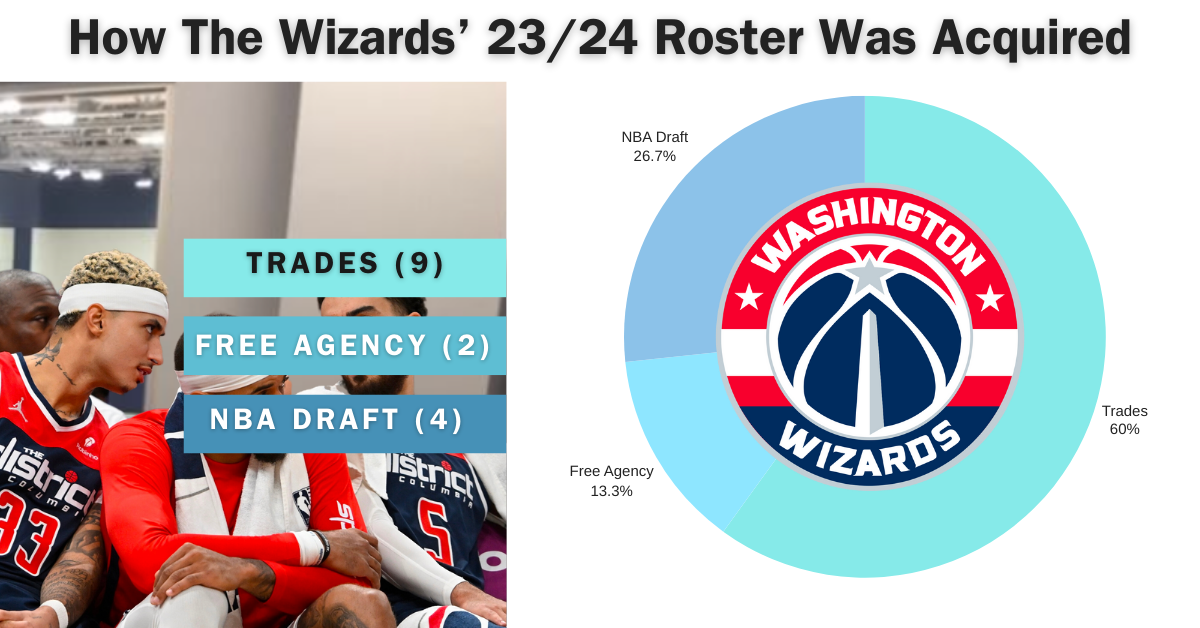 Wizards Expected To Be Traded
Wizards Expected To Be Traded
Weeks before Wizards training camp, three of the team’s vets were already embedded in trade rumors.
Gallinari has politely been positioning himself to be traded again since arriving in the nation’s capital via trade.
The 35-year-old forward told FortyEightMinutes and other media members at the Wizards’ Media Day that he didn’t expect to be traded from the Celtics (an event that happened eight days after exercising his 2023-24 player option), mentioning that he was looking to utilize his time in Washington to prove he could still play in the NBA tearing his ACL in 2022 02.
Gallinari also signaled that playing the center position on a regular basis would extend his career and provide value to NBA teams.
The Wizards appear to be in lockstep with Gallinari, providing the former No. 6 overall pick with a role that simulates how a contending team might utilize him.
Through two months of the season, Gallinari ranks fourth on the Wizards in win shares while playing just under 15 minutes per game with 88% of his total minutes coming at the five spot.
He’s only played in one back-to-back this season, though he departed from the second contest after less than five minutes of court time because of lower-back tightness (12/27 vs. Toronto).
It’s a positive sign that the Wizards put him out there, providing Gallinari with at least an opportunity to prepare himself for back-to-back NBA games for the first time since tearing his ACL.
Rival scouts have likely already compiled their reports on Gallinari, so assuming that his lower-back tightness isn’t serious, he should have several trade suitors.
- Potential Fit: Teams such as the Sixers and Clippers make sense as logical trade destinations for the veteran big man.
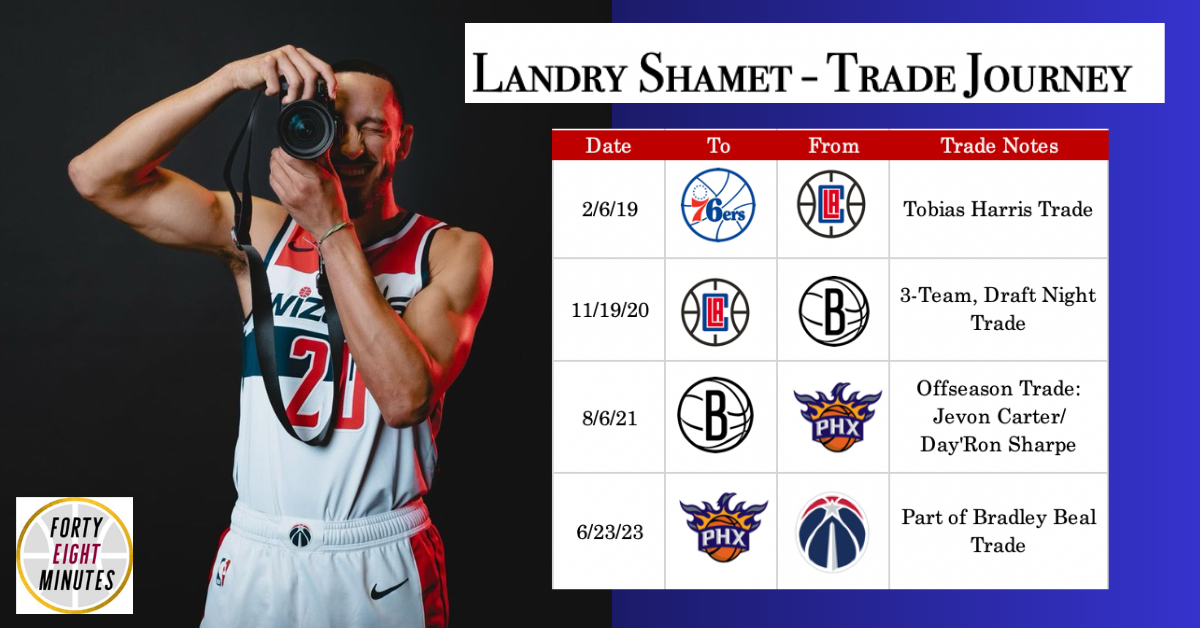
Landry Shamet has been traded four times already in his career and his unique contract with the Wizards might signal that he should expect to move again.
The former Sixer is making $10.25 million this year and is scheduled to earn $22.75 million over the two ensuing years, though no future money is guaranteed (his 2024/25 and 2025/26 salaries only become guaranteed if he’s on his team’s roster past June 29 ahead of each season, respectively, per HoopsHype).
He turns 27 in March and his shooting (career 38.9% from three) as well as his team-friendly contract makes him a decent bet to celebrate his big day in another city.
- Potential Trade No. 5 For Shamet: Minnesota appears to be a fit if they look to replace Shake Milton‘s minutes in its rotation.
Delon Wright signed a two-year, $16 million deal with Washington during the 2022 offseason and unfortunately, injuries have robbed him of participating in Wizards basketball for stretches during each season.
When on the court, Wright has been productive. He’s the only Wizard who has seen over 150 minutes this season to have a positive net rating. Through 60 career games in Washington, Wright is sporting a 17.2 PER, which is slightly higher than his 15.7 career PER.
If I were to editorialize, I would write that Wright doesn’t belong on the Wizards. He’s played too well and he should be able to seamlessly elevate the rotation of a realistic playoff and/or play-in team at some point before the trade deadline.
- Potential Fit: If the Rockets look for veteran bench help ahead of the deadline, Wright would be an asset to Ime Udoka‘s squad. Houston dealing DeMatha Catholic’s own Victor Oladipo to Washington (in addition to a second-round pick) is a trade that would not only be beneficial to the Wizards’ finances this season but also bring some excitement about the future—even if Oladipo’s injuries create major hurdles to him ever returning to All-Star form.
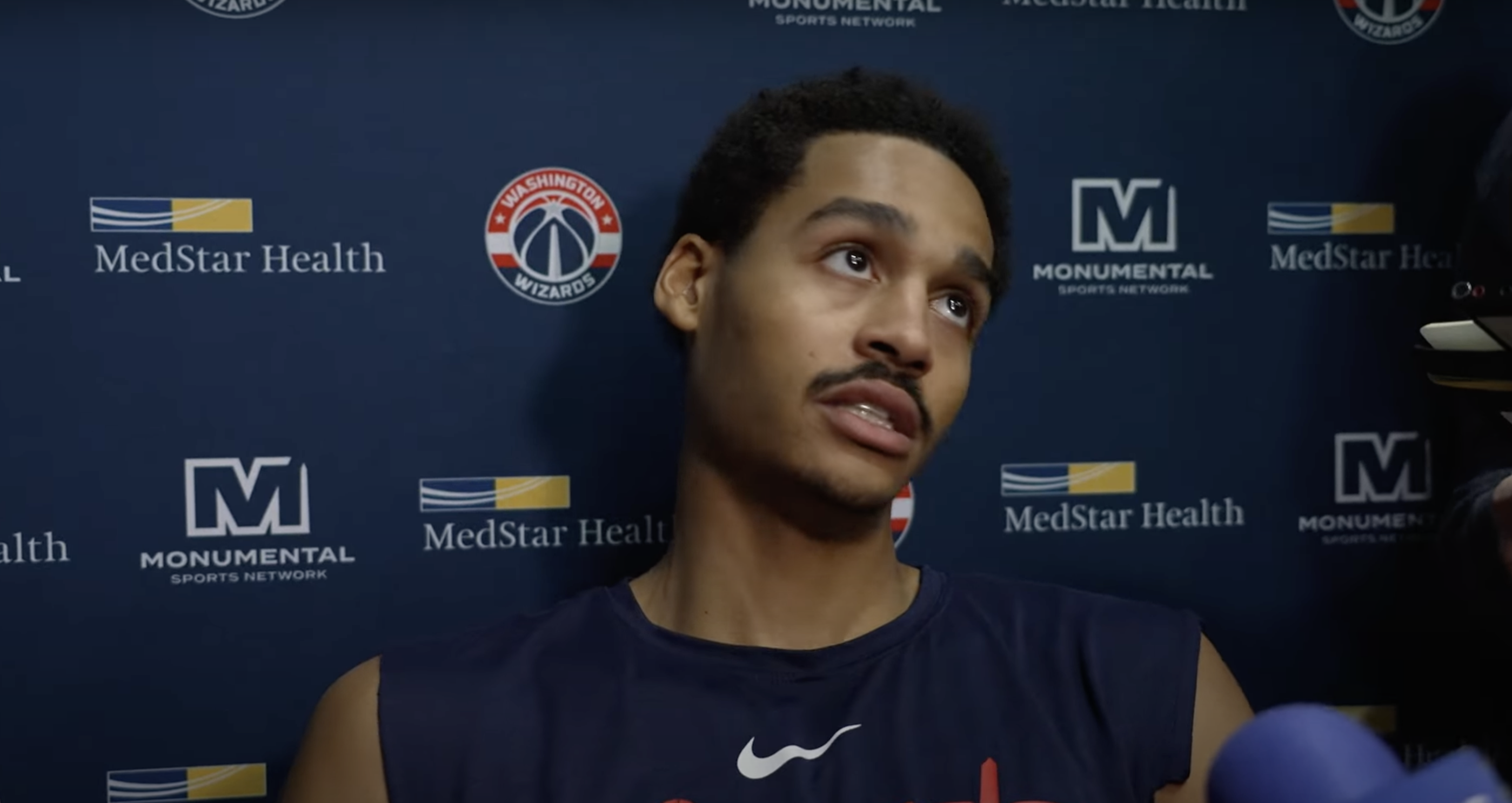 Biggest Name Who Could Be Traded
Biggest Name Who Could Be Traded
If Poole’s time in Golden State was a roller coaster, his stint in Washington is a Tilt-a-Whirl: There’s been a lot of spin.
After the Warriors were eliminated from the 2023 playoffs, Poole told Logan Murdock of The Ringer that he didn’t see why he wouldn’t return to the Warriors.
“It wasn’t a bad year. I mean, career highs in two categories,” Poole said back in May after a season where he saw slight upticks in points per game (18.5 to 20.4) and assists per game (4.0 to 4.5) while also setting a career-high in turnovers and recording his lowest PER and field goal percentage since his rookie campaign.
Amazingly, just two months later, Poole was traded to the Wizards.
Four months after the trade, Poole introduced himself at Wizards Media Day, discussing his insights into “what it takes to build a championship culture.”
During the second day of Wizards training camp, Poole reunited with Murdock and explained that in preparation for his lead role in Washington, he had been watching Navy SEAL training videos during the offseason to study how to lead troops.
Minutes after his one-on-one with Murdock, Poole was scheduled to close out the practice by speaking with the remainder of the media (including FortyEightMinutes), though instead of standing with the group of media as his coach and teammate did, Poole asked a staffer for a chair to sit down.
A half-dozen iPhones were pointing down at Poole, recording his boastful words about leadership when a test of the National Emergency Alert System set the devices off, leading Poole to joke that they were ringing for his arrival in Washington.
Allow me to editorialize here: the scene at the Wizards practice facility wasn’t that serious.
Most everyone was laughing with the 24-year-old guard and it had a first-week-of-school vibe to it (as many training camps do). It was less than a week into the Wizards formally ushering in the Poole era and some might say that scene, along with the team-run fashion show the following night, would be a foreshadowing of just how unserious Poole’s debut run with Washington would eventually be.
When evaluating trade value and long-term player projections, antidotes such as Poole’s kickoff in D.C. certainly play a role.
Rival executives might not be in the building every day but there’s plenty of talk around the league in an attempt to gather accurate intel. Executives take note of how players handle themselves in a league with ever-changing situations; Poole’s ongoing scouting report has many chapters.
Poole later describing his arrival in D.C. to Yahoo Sports as a “good situation” to “just kind of have [his] own team” and “play [his] own type of basketball” didn’t go unnoticed around the league.
Poole’s lamenting that he previously “had to fit into the mold” that the Warriors already established in Golden State also didn’t go unnoticed.
That mold produced four championships and six NBA Finals appearances. As of this writing, Poole’s “type of basketball” has produced a total of six regular season wins in Washington.
Less than two weeks after Poole’s comments, there were leaks to well-established national NBA reporters that the Wizards didn’t view Poole as a “cornerstone player” and that the team acquired the point guard in an attempt to rehabilitate his trade value.
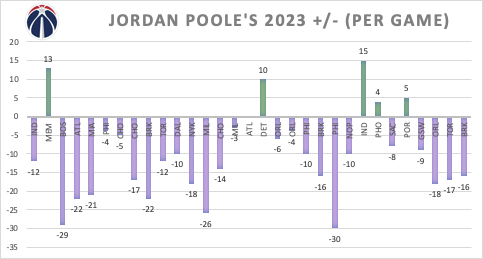 Poole has recorded a positive raw plus-minus on just five occasions and Washington went 4-1 in those contests. Through 25 appearances where Poole posted a negative plus-minus, the Wizards are 2-23.
Poole has recorded a positive raw plus-minus on just five occasions and Washington went 4-1 in those contests. Through 25 appearances where Poole posted a negative plus-minus, the Wizards are 2-23.
Most statistics should be seen as a means of filtering information rather than a direct line to a conclusion. However, more context behind the data here does Poole no favors.
Poole’s top games for the Wizards occurred during wins against:
- The Grizzlies without Ja Morant, leaving 35-year-old Derrick Rose getting significant run.
- The Pistons midway through their historic losing streak.
- The Pacers in their first regular season contest coming off of their In-Season Tournament championship game appearance in Las Vegas.
- The Trail Blazers in a game where the Wizards nearly blew a double-digit fourth-quarter lead.
Through 30 games as a Wizard, Poole owns negative 0.9 win shares, which is the lowest mark among the 517 NBA players to see action this season, according to Basketball Reference 03.
Subscribers to Basketball Reference’s win share stat might tell you that means he’s actively taking wins off the table for the Wizards (as few as there were expected to be). Don’t like win shares or plus-minus? There’s a plethora of other performance metrics that tell the same story. Regardless of whether you like numbers or not, it’s safe to say that Poole isn’t producing as a leading option on an NBA team.
The narrative around Poole shifted from a rising leader to a player deserving of intense public criticism to the point where some may deem it as an act of bullying 04.
It now feels a little Grinch-y outlining Poole’s figures. After all, honesty without compassion is cruelty (and I’m sure there’s a sense of apprehension when the Wizards’ PR staff include Poole’s figures as they send postgame statistical highlights to the media on a nightly basis).
To be objective, there is an element of enabling here by the Wizards.
Poole might have believed that he was a rising NBA superstar ready to lead a team to success with his “type of basketball,” though it’s difficult to believe that the Wizards’ decision-makers ever truly did.
Inferring Washington’s Poole Experiment Goals
There’s documented research suggesting that the traits that Poole showcased in Golden State would never translate to true stardom on his own.
In 2010, economists David J Berri and Martin B. Schmidt produced research accounting for what factors produce NBA wins in their 2010 book, “Stumbling on Wins.” Taking the inverse, you could easily derive what accounts for losing.
Some time has passed since the research was published and it’s certainly not the only published work on the subject. Although, Dean Oliver, who is widely known as one of the greatest statistical minds to pour his talents into basketball, is credited with contributing research to the book. Coincidentally, Oliver spent three seasons on the Wizards’ staff from 2020-2023.
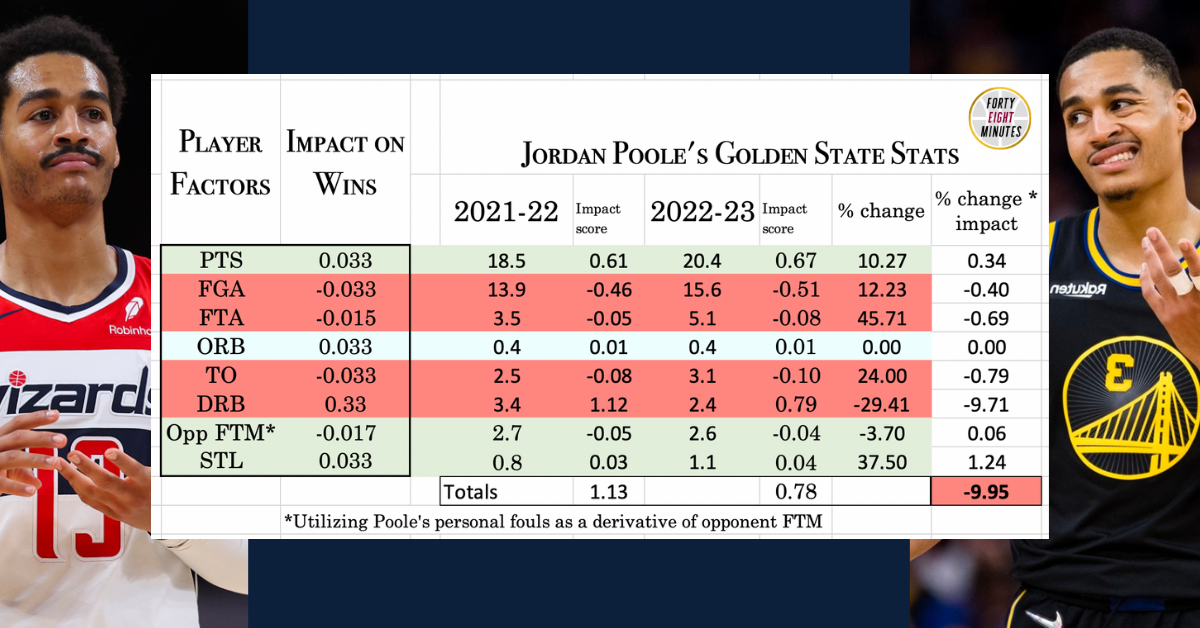
Admittedly, the table above is a simplified version of the sophisticated research. Still, it’s easy to infer why the Wizards would allow Poole to spread his wings during a season that the front office has deemed as a tanking “reshaping” campaign.
At least two of the franchise’s objectives with the Poole era are clear:
- Sink further down the NBA’s standings to gain better placement in the 2024 NBA draft lottery, which will ultimately yield the franchise its best draft pick since the early 2010s (the Wizards lose their 2024 first-round pick if it doesn’t fall within the top 12) 05.
- Continue to portray and operate the franchise as a player-friendly destination.
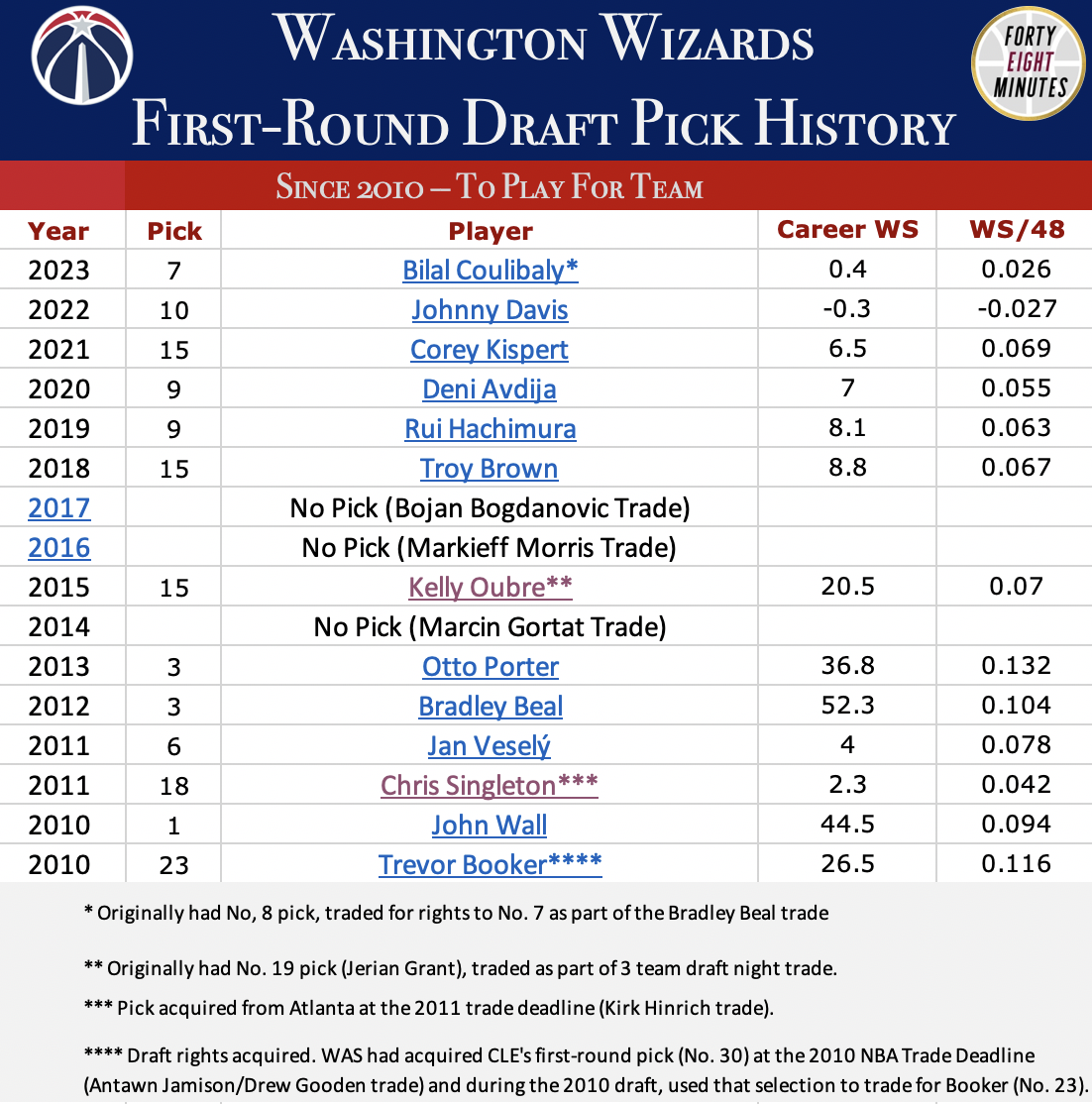
By the time the 2024 trade deadline arrives, the Wizards will have played 50 games and will likely be on target to achieve item No. 1. With item No. 2, it’s harder to project exactly what success looks like.
It’s no secret that the Wizards are aiming to become a more attractive free-agent destination and that has factored into how they handle nearly every major situation 06.
Part of Russell Westbrook‘s deal in Washington was that the front office would send him to Los Angeles if the opportunity presented itself. With Bradley Beal, leadership gave him the ability to pick his parting destination via his no-trade clause, though chatter around the league indicated that the Wizards would eventually accommodate a Beal trade request even before incorporating the clause into the record-setting $250 million deal.
Poole isn’t in the same tier as Westbrook or Beal, though the Wizards allowed him an opportunity to elevate his career toward star status.
When the Poole experiment comes to an end, the Wizards will likely handle the situation in a way that’ll paint the franchise in a positive light, something that’ll be useful in pitches to future “rising stars” who become available on the market.
Poole’s Contract
Poole has three years and $95.5 million left on his contract after this season.
If Washington wanted to simply shed Poole’s deal without taking back a questionable contract, they’d likely have to attach some compensation.
It’s possible that the front office may not pull the plug so soon given the market dynamics. Whether or not they trade Poole before the deadline (or at the very least reduce his role heading into next season) should signal how long the Wizards plan to remain on the path of devaluing wins.
Regardless, it would be shocking if Poole is on the Wizards the next time this team finishes with a winning record.
Potential Jordan Poole Trade Fits Ahead of 2024 NBA Trade Deadline:
- Chicago Bulls
- Brooklyn Nets
Luckily for the Wizards, no NBA player is truly untradable since there are usually contracts out there perceived as worse than the one on your favorite NBA team’s roster.
The Bulls and Nets are the only teams that stand out as suitors for Poole in the current NBA environment. Chicago’s situation is particularly noteworthy.
The franchise was rumored to be a firesale candidate with Zach LaVine, Alex Caruso, and DeMar DeRozan previously reported as available.
The team has rebounded a bit since those rumblings and there have been reports that the team would like “win-now” pieces if it shuffles the roster. As outlined above, Poole shouldn’t be considered a win-now player in his current role on the Wizards, though as part of a more talented club and in a reserve/decreased role, perhaps he can portray success.
There’s a Lonzo Ball-centered trade that is screaming to be spun as a win-win for the Bulls and Wizards.
Ball remains out with a knee injury and isn’t expected to play this season. Recent reports of Ball making progress in his rehab should be just fine for the Wizards as the team plans for the future (plus as Unseld mentioned, the Wizards have too many bodies on the perimeter anyway).
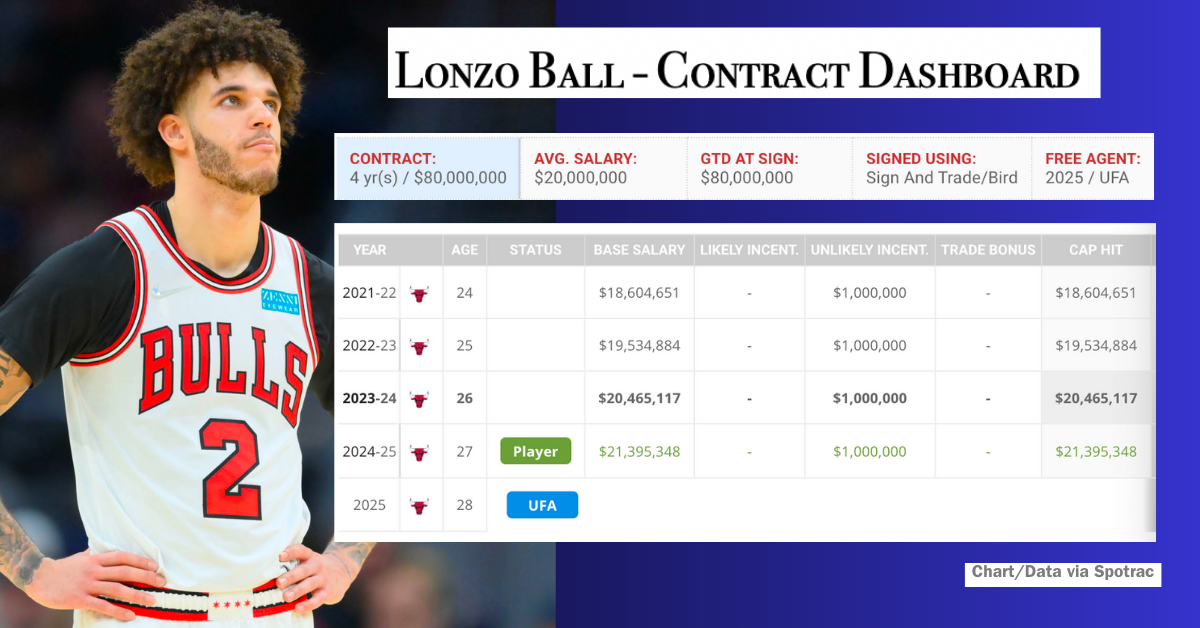
At first glance, Ball’s contract might seem like… an albatross, as the kids say. In the words of Lee Corso: “Not so fast.”
Assuming Ball’s knee injury isn’t excluded from the league’s disabled players insurance plan (as Amar’e Stoudemire‘s knee injury was with the Knicks), Ball’s full $20.5 million salary this year is estimated to be covered by insurance—given that he has already missed 41-games because of the knee ailment (the deductible) and that Ball’s contract was a top-5 salary on the Bulls when he signed in back in 2021 (the criteria to automatically have a contract enter the insurance plan).
Swapping Poole for Ball, who has just one future year remaining on his contract, would save the Wizards millions this season—even if the coverage of Ball’s salary is prorated. Such a trade would likely net Washington an additional asset or two as well (Patrick Williams stands out as someone who could be targeted).
The league’s insurance plan similarly makes Ben Simmons‘ situation with the Nets more tentable.
Simmons is out indefinitely with a back injury, though he’s making $37.9 million this season and with him missing time over the past two seasons, it’s estimated that he already hit the 41-game deductible, meaning his remaining salary is covered07.
For either Brooklyn or Chicago, taking a spin with Poole would be a calculated risk, one that comes with less downside for the Bulls than the Nets given that Simmons still arguably has more trade value than Ball.
The Best-case scenario: Poole is an entertaining contributor in a reasonable role for the Bulls as they attempt to turn around their season, providing more on-court value than Ball was able to provide because of his injury.
The worst-case scenario? Poole doesn’t make personal adjustments when traded to the Bulls and continues to struggle, though instead of shutting him down, Chicago can fully employ Poole’s “type of basketball” later in the season, giving the point guard a chance to secure 2024 draft positioning for two franchises.
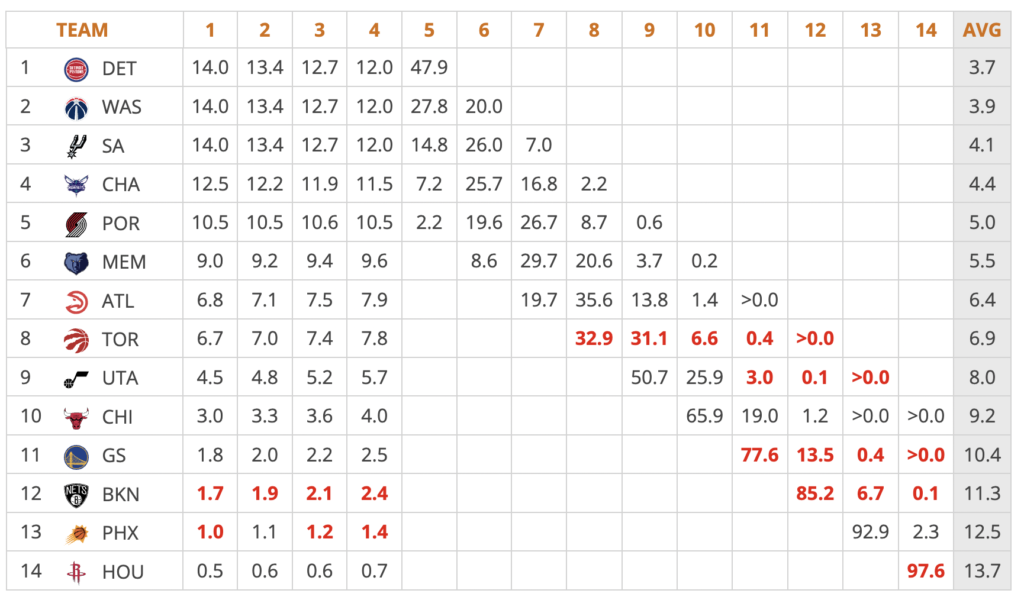
Wait-And-See Wizards
- G/F Corey Kispert
- F Kyle Kuzma
Kyle Kuzma almost had his own tier here, though we’ll couple him and Corey Kispert as holdovers from the Tommy Sheppard regime who are available in trade talks but seem more likely than not to stay in Washington.
 Kispert, who has accumulated the 10th-most career win shares (6.5) among 2021 NBA Draftees, appears on his way to having a nice career as a role player in the NBA.
Kispert, who has accumulated the 10th-most career win shares (6.5) among 2021 NBA Draftees, appears on his way to having a nice career as a role player in the NBA.
Given his shooting (38.9% career three-point mark) and reasonable $3.72 million salary, it’s likely that the Wizards could find some combination of multiple second-rounders and/or a younger prospect from another team if they really wanted to move him before the deadline (again, I don’t envision it).
Kyle Kuzma‘s future is much more interesting.
If the Wizards are looking at a multi-year rebuild, the 28-year-old forward is a more logical trade candidate. Kuzma was rumored to want out of Washington last season, though he’s seemingly been happy in Washington since he inked his four-year, $90 million extension earlier this year (Kuzma won’t be trade-eligible until January 15).
Kuzma’s contract is considered valuable by some around the league with Jake Fischer of Yahoo Sports writing that the forward could net “legitimate first-round capital” in a trade. The legitimacy of those rumors could dictate Kuzma’s future.
On the other hand, having some sort of continuity on the court from season to season is valuable for the Wizards beyond giving season-ticket holders, fans, and tourists in The District an idea of who they’ll paying to see play basketball when they buy tickets for games at the Capital One Arena.
If Washington’s front office embraces a roster-building strategy that balances a young, higher-than-your-typical-Wizards-team ceiling with one that can be more competitive next season while maintaining some familiar faces on the roster, both Kispert and Kuzma can be a part of it.
Trade season could go either way for this pair. If any rival GM could not bear to continue in their professional life without one of the Wizards on their team, there wouldn’t be much resistance from Washington provided the offer is right.
Wizards’ Tradable Two-Way Contracts
In the history of the NBA, only two players on two-way contracts have been traded: Johnathan Motley from the Mavericks to the Clippers in 2018 and Julian Washburn from the Grizzlies to the Warriors in 2019 (h/t to CBA guru and my former editor Luke Adams at Hoops Rumors).
There is a stipulation stating that two-way players can’t be traded until 30 days after they sign their deal, so Jules Bernard, who signed his contract on December 8, can’t quite be traded yet.
Bernard has seen a total of 10 minutes for the Wizards as of this writing. Eugene Omoruyi (92 minutes) and Jared Butler (111 minutes) have each seen more action for Washington’s NBA franchise.
None of the three prospects is likely to become the NBA’s third-ever two-way player to be traded.
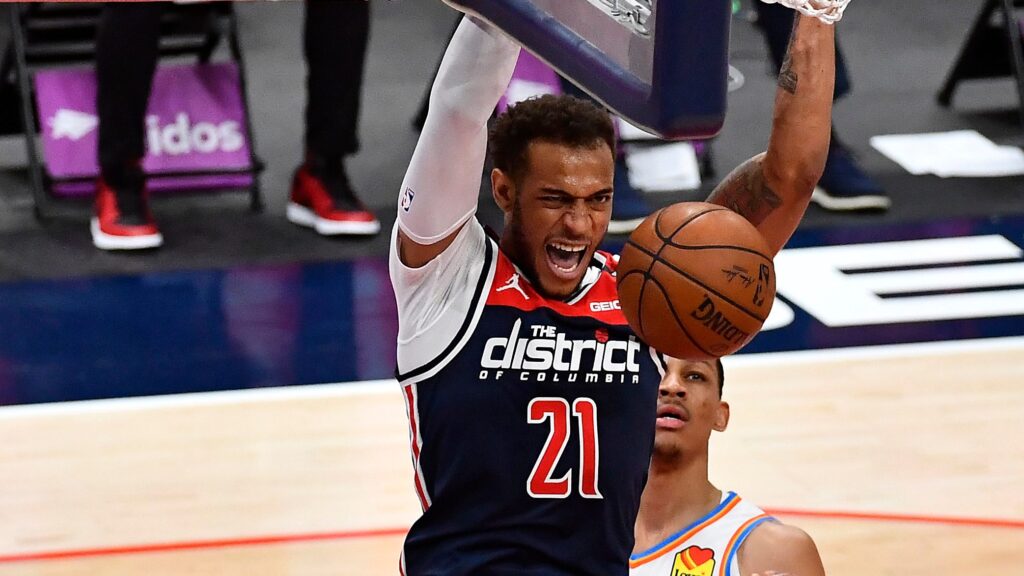
Trade Are Possible
🏀 Tyus Jones, who arguably has the most trade value among players who are likely to be dealt, is quietly having an effective season.
Like Poole last year, he’s averaging career-highs in points (12.5) and assists (5.4) in a year where he’s seeing the most minutes per game he’s ever received (28.0).
Unlike Poole last year, his underlying statistics are more impressive with Jones producing career-bests in “advanced stats,” such as true shooting percentage (62.1) and. PER (17.5).
Jones is one of two Wizards to record over 2.0 win shares this season (along with Gafford).
The 27-year-old point guard will be a free agent at the end of the year and according to the latest trade rumors, the Wizards could be offered some significant draft capital for Jones ahead of the deadline. While he would be a nice fit as a long-term piece in the DMV, he certainly can help a rival team compete during the remainder of the season (the Cavaliers, Timberwolves and Suns stand out as logical trade partners).
🏀 The Wizards are Mike Muscala‘s sixth NBA home. He hasn’t consistently been in the rotation this year, only seeing 15 minutes or more on seven occasions.
The first five of those didn’t produce anything spectacular, though his recent 23-minute, +15 plus-minus against the Kings and 31-minute, +21 plus-minus contest against the Nets were encouraging.
One future second-round pick sounds about right if a rival team wants to give the 32-year-old a new home.
🏀 Daniel Gafford, who is under contract through the 2026 offseason, has played the most games for the Wizards among active players.
Gafford has arguably been the Wizards’ best player this year. Did you know he leads the league in true shooting percentage and ranks third in offensive rating as of this writing?
It’s easy to envision a team sending a few legitimate second-rounders (like the 2024 selection that the Raptors received for OG Anunoby) and a prospect to the Wizards for Gafford. The Mavericks have long made sense for Gafford as a fit next to Luka Doncic, though it’s just as it’s easy to envision him remaining with the Wizards through the deadline.
🏀 Anthony Gill seems more likely than not to stay. The Wizards matchup with the Hawks on New Year’s Eve is the University of Virginia product’s 150th game for the team. He should have plenty of time to add to that tally in the new year.
🏀 Ryan Rollins‘ profile is a nice way to end this year’s 2024 Wizards Trade Preview. He’s only seen a total of 66 minutes over the course of 10 games for Washington and although much of his court time has come at the end of blowout losses, allow me to provide a positive stat:
- Among the 434 players who are averaging at least six minutes per game during their NBA appearances, Rollins leads all players with a 38.8 net rating.
The small sample size has given Wizards’ fans hope and there’s more reason for optimism if you’ve been following the 21-year-old point guard’s play for the Capital City Go-Go of the G League.
While a Rollins trade is possible, it’s not probable. Washington likely values Rollins higher than any rival team given he already has some fan equity and any additional progress he makes is another feather in their Bradley Beal trade cap.
Sources & Credits
Stats via NBA.com, Basketball Reference, Cleaning the Glass.
Photos altered and utilized in dashboards from: Getty Images; Washington Wizards’ website and Instagram feeds; Johnny Davis‘ Instagram feeds, and X account of Monumental Sports’ Chase Hughes.
References include Spotrac, RealGM’s Future Pick Tracker, Stumbling on Wins, The Ringer, Yahoo Sports, The New York Post, Hoops Rumors, HoopsHype, Tankathon and Bullets Forever.
Fourth-Wall Footnotes
01.
Yes, the Wizards moved from No. 8 to No. 7 (Bilal Coulibaly) in the 2023 draft as part of the Beal trade, giving up two second-rounders to Indiana. Aside from moving up one spot, here are the net assets received stemming from the Beal trade:
From Golden State:
- Jordan Poole
- Patrick Baldwin Jr.
- Ryan Rollins
- 2027 second-round pick
- 2030 top-20 protected first-round pick (turns into a second-rounder if not conveyed)
- Cash Considerations (undisclosed)
From Phoenix
- Landry Shamet
- 2024, 2026, 2028, 2030 first-round pick swaps.
- 2024, 2025, 2026, 2027, 2030 second-round picks.
- Cash considerations (approx $3.5 million)
02.
Gallinari signed a two-year deal with the Celtics during the 2022 offseason, planning to help the defending Eastern Conference champs compete for a title. He suffered a torn ACL during FIBA World Cup qualifiers and never suited up for Boston. He was traded to the Wizards as part of the Kristaps Porzingis trade this past summer.
03.
All references to Win Shares are from Basketball Reference’s model, which differs slightly from Bill James’ Win Shares model in that it allows for negative contributions whereas a mark of zero is the lowest Bill James’ would go.
04.
The Wizards haven’t found themselves in national headlines too often this season, though a pair of Kevin Garnett podcast appearances illustrate the narrative shift:
05.
Washington traded the protected pick to Houston as part of the Russell Westbrook acquisition. It’s since been re-routed to New York via Oklahoma City’s 2022 draft night trade (Ousmane Dieng trade) via Houston’s 2021 draft night trade (Alperen Sengun trade).
It’s top-10 protected in 2025; top-8 protected in 2026 and will convert to two second-rounders if not conveyed in 2026 (as the team’s 2026 and 2027 second-round picks).
06.
One example: It took less than five minutes into Bradley Beal’s re-signing press conference last year for team owner Ted Leonsis to mention that signing their star to a $250 million contract would aid the franchise in attracting free agents.
Leonsis likely isn’t wrong. Attempting to position the organization as player-friendly in the most player-driven professional league in North America might rightfully be more important for the Wizards than the potential marginal gains of each roster transaction.
07.
It’s worth noting that I do not have access to the NBA’s insurance policy, so several educated assumptions are being made. With Simmons, how the league’s insurer is classifying his missed 2021-22 season with the Sixers could also play a role in how his contract is covered.
